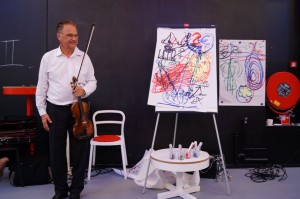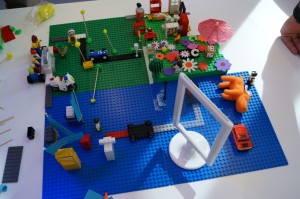Part 1: The Learner’s Experience

Violinist Miha Pogačnik at a forum session on personal & corporate transformation as told by Bach. Photo by Jason Hsu
Seven days. Two days of orientation that leaves you aching in places where you did not even know you had muscles. Five days of ‘class’ (if you can call it that) that bends your brain in previously unimagined ways. 34 brilliant, high-achievers as fellow-travelers and participants (I still wonder if I got in there by mistake :)). Insanely long days that started at 9 am and ended after 11 pm, sometimes waaay after that. Pressure cooker of an academic environment and agenda where you are racing to beat the clock and finish your project – every single day. Faculty and staff who urge you to stretch your mind and body everyday and who seem to take extraordinary pleasure in asking us to do the impossible.
And of course, the pleasure of beating the clock and accomplishing what you thought was impossible. The expansion of your worldview thanks to a scholarly forum or session. New ideas that spring up from a perceptive question or comment from a fellow participant. Faculty that is waiting to high five you when you are done.
Welcome to THNK, Amsterdam’s School of Creative Leadership. What is THNK? Here is a short description from the website:
THNK is a school on a mission: to develop the next generation of creative leaders that will have a significant societal impact in our world. THNK provides an 18-month, part-time, post-graduate program for a carefully selected group of international top talent…This isn’t just about generating ideas. It’s also about making it happen.
I am fortunate to be part of the second batch of THNK (thanks Katherine Maher). It has been almost 10 days since I got back from the first session in Amsterdam and I am still mulling over all the learning from those 7 days. I know I am not the only one who has been deeply impacted. See blog posts from Rachel Sinha and Jillian York, who are also on the same journey.
I savored the THNK experience from two different but related angles – as a learner as well as an educator. Here is a window into both those worldviews:
The Learner’s Experience: THNK’s unique and incredible learning model makes me think of it is a school for solving global challenges of the future. Yesterday’s learning methodologies of reading a corporate case study or learning how someone else solved a problem will not take us too far in the new world where the fundamental framework of society itself is in a shift. Enter THNK with its thoughtful learning process:
- Provide the framework and methodology for finding innovative solutions to complex problems
- Create a stimulating environment where a diverse (by sector, geography, age, gender) group of leaders are brought together to learn and tweak this framework
- Challenge them with complex real-world problems
- Mix 1, 2, and 3 above judiciously and watch as creative leaders are born

A Prototype of a Westergasfabriek (WGF) machine 2 machine living lab (note: not our team’s)
Photo by Jason Hsu
It is this combination of #1, 2, and 3 that enriched my learning experience. For instance, on Day 1 of our first session, after our initial introduction to the THNK creation flow, we were teamed up and let loose on Westergasfabriek (WGF), THNK’s physical location (related note: WGF is a reclaimed industrial site that has now been converted into a huge park with office buildings, entertainment, and recreation facilities). We had an intriguing question to answer that day:
How might we turn the WGF area into an exciting M2M (machine 2 machine) living lab given that smart street lighting (IP-enabled) will soon be installed in the WGF area.
Through the day of learning components of the creation flow – sensing, visioning, prototyping, and scaling – we also came up with cool ideas for how the park can utilize internet of things, the next generation technology. Our team’s ideas included:
- crowdsourced trash reporting utilizing built-in capabilities in the street lights,
- smart lights that create visible pathways that help people find each other, and
- street signs that automatically change language based on a user’s cell phone language setting (street light will communicate with the cell phone using either bluetooth or near field communication NFC technologies).
That was just our team. There were 12 other teams that were coming up with cool ideas such as these. And, every team also had at least one prototype. All in a day’s work.
The best part of this whole day was not the cool ideas and prototypes. It was the fact that this whole exercise was done in cooperation with WGF management whose staff provided us with data (e.g., what are smart street lights’ capabilities) and were also present throughout the day, answering questions and listening to our ideas. So, who knows, some of these ideas may actually see the light of day (pun intended! :)).
This intermix is what makes THNK unique in my opinion. This is in a way the future of education, and I am especially honored to be part of this.
(coming soon: Part 2 – The Educator’s Experience)
